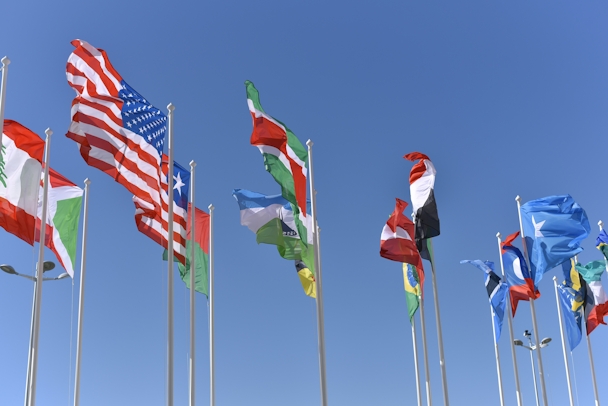How Locaria’s work to redefine marketing localization strategy became award-winning
Winning Gold at The Drum Awards for Agency Business in the Service or Business Innovation category is Locaria. Here's how, in its own words, it redefined its approach to media planning for global campaigns.

How Locaria's approach to localization netted it a gong at this year's The Drum Awards / Vladislav Klapin via Unsplash
There are leaks in the pipe between media planning and multimarket activations: losses of efficiency that are only becoming more apparent as Western economies struggle to maintain growth while emerging markets such as China, India, and those of Southeast Asia continue to gain prominence.
This puts a new onus on ambitious brands to create content for ever more disparate audiences, requiring adaptation into an increasingly diverse set of languages.
That increased output has meant that inefficiencies in multilingual campaigns have become easier to pinpoint. These ‘leaks in the pipe’ have manifested as omnichannel inconsistencies, hours wasted on brand adherence quality checks, and a mismatch in quality and performance between markets.
The objective
Traditionally, our services at Locaria have been sought for specific linguistic or performance aspects of a campaign. But what would happen if we were given a more holistic role from strategy through to execution?
Our objective, driven by demand from our biggest clients to find further efficiencies in global campaigns, was to create a system for media planning which merges media, data, technology and language skills to pinpoint opportunities to drive better performance throughout the execution of multilingual market activations. Essentially, this would be a system to locate any leaks in the pipe which could be plugged. We named it 'Media Localization Planning'.
Want to go deeper? Ask The Drum
The work
The project began by sitting down with our global clients (including HiBoB, Finnish Design Shop and Moët) to unpick their traditional strategic methodologies for multimarket activations. The usual suspects appeared: choosing the right media plan per market, the budget, the audience, the performance KPIs...
But during those conversations covering strategy, creative, media and production, there was rarely any talk about localization strategy. In fact, most people were unaware what a localization strategy is, or could even explain the difference between translation, localization, transcreation, culturalization, regionalization, adaptation, origination or copywriting (let alone the impact each has on different digital marketing channels). All of these localization strategies demand different talent, timelines and budgets.
One of the key problems is that RFPs simply never mention these localization strategies. Currently, everything happens in siloes: paid media RFPs, organic media RFPs and translation RFPs.
The latter is often managed by an in-house localization manager who understands CAT tools (localization glossaries and terminology databases) and word counts, but not how each localization methodology impacts different marketing activities, platforms and formats. Even more problematically, these localization managers rarely connect with data, media and performance marketing teams. Multilingual expansion is often a siloed afterthought that comes at the end of the advertising planning journey. This needed to change.
Through the years and countless projects we've developed unique linguistic approaches tailored to paid, organic and owned media with great success. The time had come to identify their synergies. Our scope of work would no longer be an afterthought or siloed to specific channels, but considered across every stage of the activation, from strategy to performance optimization and cross-channel consistency.
Advertisement
Beginning with clients who had brought us in on translation projects, instead of simply receiving the campaign material once completed by the creative agency, our teams would now connect with the creative and production teams early. Their mission: to first understand the concept created and produced for the source market, before pressure testing ideas, concepts, and taglines in the target market, conducting ethnographic research and providing rationales for different versions. This step would allow us to understand the right localization strategy to use once the language expansion stage is reached, resulting in time and cost savings.
The results
What does this look like in practice? We applied methodology testing practices on ad copy for an international sportswear brand to learn which localization methodologies provided the best click-through rates (CTRs) for different markets. Results showed that for German, French, Spanish and Italian a translation approach often generated good results, but for non-Latin based languages such as those found in Asia and the Middle East, a combination of origination and transcreation performed better on search and social ads.
By understanding what localization methodologies worked in which markets at this early stage, we could then apply the data to the language expansion stage which consequently saves time, money and improves performance. This resulted in an uplift of up to 30% in CTRs across targeted markets.
When it comes to performance optimization once content is live, the campaign-holistic view taken by Media Localization Planning allows for a high-level understanding of resources across what was traditionally siloed into paid, organic and translation to search for the biggest budget efficiencies possible.
Advertisement
When we tested the concept with a client with whom we were already working on multilingual PPC and SEO in siloes. What if we were to take a more holistic view of the two? We developed our proprietary incrementality testing framework. Through Q3 and Q4 of 2023 into Q1 of 2024 we used our knowledge of their paid media channels and SEO performance to see whether pure brand search campaigns were really working. This was no small matter of optimization.
Our tests indicated no significant incremental lift in orders and revenue from pure brand campaigns thanks to the strong impact of SEO work. Brand campaigns did not demonstrate an incremental impact beyond their costs during business-as-usual and standard sales periods. Deactivating these pure brand campaigns resulted game-changing efficiency, proving the value of our silo-breaking endeavours.
Our final hurdle has been the centralization of cross-channel consistency and brand quality checks. Launched In 2024, Penta-Con was the final piece: our cross-channel content consistency checker constantly checks every aspect of language use (style, tone of voice, grammar, syntax, brand rule) across all channels, including third parties. It then sends alerts with detailed reports on any inconsistencies so that content teams can act and fix them at speed. Our client teams have been using it to great success, saving hours from the QC process by removing time inefficiencies while making notable cost-savings.
Media Localization Planning has successfully broken down silos between organic, paid, and translation efforts, eliminating duplicate work, misunderstandings, and wastage while enhancing cross-channel and cross-market understanding. The holistic view has allowed performance metrics to be applied to multilingual paid media, SEO and content generation. It has allowed us to achieve and maintain omnichannel content consistency, saving countless hours in brand adherence quality checks.
Now, the same high quality content can be delivered across all languages to the highest standard, not just in the source market and the largest international countries. Locaria’s 25% growth in 2023, as well as the signing of new clients including Estée Lauder and Lenovo, has largely been attributed to the launch of this new offering, an impressive statistic considering the headwind faced by most agencies.
Ready to get your work recognized on a global stage? Enter The Drum Awards today. Need more inspiration? Read our Award Winning Case Studies.
